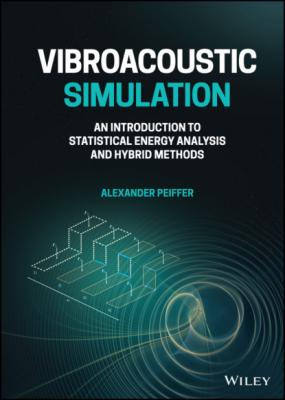Vibroacoustic Simulation. Alexander Peiffer
Чтение книги онлайн.
Читать онлайн книгу Vibroacoustic Simulation - Alexander Peiffer страница 12
 alt="StartLayout 1st Row equals ModifyingAbove u With caret Subscript 0 Baseline e Superscript minus zeta omega 0 t Baseline c o s left-parenthesis left-parenthesis 1 minus zeta right-parenthesis Superscript 1 slash 2 Baseline omega 0 t plus phi 0 right-parenthesis EndLayout"/> (1.14)
alt="StartLayout 1st Row equals ModifyingAbove u With caret Subscript 0 Baseline e Superscript minus zeta omega 0 t Baseline c o s left-parenthesis left-parenthesis 1 minus zeta right-parenthesis Superscript 1 slash 2 Baseline omega 0 t plus phi 0 right-parenthesis EndLayout"/> (1.14)
The motion is oscillatory with a frequency that is lower than in the undamped configuration:
Introducing the initial conditions u0 and vx0 at t = 0 the solution for the initial amplitude u^0 and phase ϕ0 reads as:
The damped oscillatory motion is illustrated in Figure 1.3. It shows a decreasing motion that never approaches the equilibrium.
Figure 1.3 Damped, sinusoidal motion of the underdamped oscillator. Source: Alexander Peiffer.
1.1.4 The Critically Damped Oscillator (ζ = 1)
The last case is a transition between both systems. There is only one root s=−ω0, and the solution in Equation (1.4) becomes:
This solution does not provide enough constants to fulfil the initial conditions, so that we need an extra term te−ω0t:
Introducing the initial conditions again, the constants are:
Critically damped systems can be of practical relevance, because the motion returns to rest in the shortest possible time, which is useful if periodic motion shall be prevented. In contrast to the overdamped oscillator the equilibrium is reached as can be seen in Figure 1.4.
Figure 1.4 Motion of the critically damped oscillator. Source: Alexander Peiffer.
Let us summarize some facts and observations about free damped oscillators:
1 Oscillation occurs only if the system is underdamped.
2 ωd is always less than ω0.
3 The motion will decay.
4 The frequency ωd and the decay rate are properties of the system and independent from the initial conditions.
5 The amplitude of the damped oscillator is u^(t)=u^0e−βt with β=ζω0. β is called the decay rate of the damped oscillator.
The decay rate is related to the decay time τ. This is the time interval where the amplitude decreases to e−1 of the initial amplitude. Thus, the decay time is:
1.2 Forced Harmonic Oscillator
When an external force F^xcos(ωt) is exciting the damped oscillator as shown in Figure 1.1 b), applying Newton’s second law we get for the equation of motion:
This is an inhomogeneous, linear, second-order equation for u. The solution of this equation is given by a particular solution uP(t) and the solutions of the homogeneous Equation (1.1) uH(t).
Any linear combination of the homogeneous solution can be added to the particular solution because it equals zero.
1.2.1 Frequency Response
There are several methods to determine the particular solutions, like Laplace and Fourier transforms. Here, complex algebra will be used1. Amplitude and phase are given by a complex pointer denoted by bold italic type as depicted in Figure 1.5.
Figure 1.5 Complex pointer, amplitude and phase relationship. Source: Alexander Peiffer.
Fx is the complex amplitude of the force, and the Re(⋅) expression is usually omitted. The displacement and velocity response is then given by